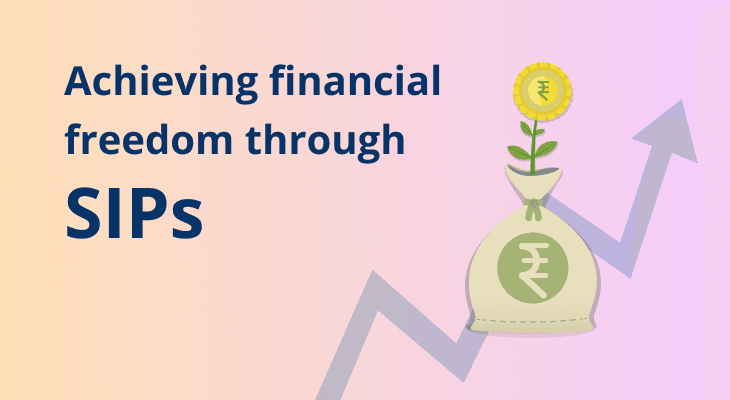
Achieving financial freedom through SIPs
For most people, Systematic Investment Plans (SIPs) and financial freedom may seem like an antithesis – a figure of speech that presents two contrasting ideas. SIPs involve small, regular investments, sometimes as low as ₹100 per month, while financial freedom typically suggests the availability of a substantial corpus. Yet, SIPs are one of the most effective ways to achieve financial freedom. This article will explain the meaning and benefits of SIPs and how they can contribute to financial independence.
What are SIPs?
Mainly offered by mutual fund companies, banks, and investment platforms, an SIP is one of the two main modes to invest in mutual funds. It allows systematic and regular investments in the mutual fund of your choice at your convenience. The minimum investment amount for SIPs is usually ₹ 500 per month, with some fund houses accepting as little as ₹ 100 per month. Moreover, you have the flexibility to choose your investment frequency, which can be daily, weekly, monthly, quarterly, half-yearly or even yearly.
How do SIPs work?
Once you register for an SIP, you must authorise auto-debits from your bank account for a specific amount and date. This is done through an Electronic Clearing Services (ECS) or National Automated Clearing House (NACH) mandate, which details your SIP amount, date, and frequency. The ECS or NACH acts as a standing instruction for your bank to debit the specified amount at the specified time and credit it to the bank account of your mutual fund scheme. Once the transaction is processed, mutual fund units are allotted to you based on your SIP amount and the applicable Net Asset Value (NAV).
Let’s say you start a monthly SIP of ₹ 1,000 in XYZ mutual fund with the 24th as your SIP date. Now, ₹ 1,000 will be debited from your account on the 24th of every month and used to purchase mutual fund units. If the NAV on that day is ₹ 50, you will be allotted 200 units. This cycle continues until you decide to stop your SIP.
How do SIPs contribute to financial freedom?
The benefits of SIPs align well with the key requirements for achieving financial freedom. Here is how:
Start investing earl: Low minimum investment
SIPs are built on the idea of small yet regular investments. A low minimum investment amount gives you a chance to start your investment journey early. For instance, college students or people with limited income do not have to wait for too long to take their first step toward financial freedom.
Develop financial discipline :Automated saving and investing
With a monthly investment commitment, you tend to start spending cautiously and saving consistently. This habit of setting aside money regularly inculcates financial discipline in life – an element key to achieving financial freedom.
Minimise risk: Rupee cost averaging
While investments expedite the wealth creation process, they come with certain risks. The highly volatile nature of markets causes mutual fund NAVs to fluctuate daily. SIPs help navigate these uncertainties through rupee cost averaging. By investing across different market cycles, you get fewer units when prices are high and more units when prices are low. This averages out your cost of investment over a period of time. Thus, SIPs help tackle market volatility while building wealth.
Growing wealth through compounding
Compounding, often regarded as the eighth wonder of the world, has the potential to convert small investments into a large corpus over time. This is because you not only earn returns on your principal but also on the returns that accrue. However, to harness the power of compounding, two factors are crucial – starting early and investing regularly for the long term. SIPs facilitate both. Moreover, with no fixed tenure, you can stay invested for as long as you wish and allow your wealth to grow over time.
Flexible SIPs
A rigid financial plan can often lead to setbacks. Your financial freedom journey should easily accommodate the changes in your life and the market as a whole. SIPs offer the needed flexibility through various types of SIP plans. For instance, a step-up SIP automatically increases your SIP contributions at specified intervals. On the other hand, when you choose a flexi SIP for investment, you are allowed to increase or decrease your SIP contributions based on your circumstances. This ensures your investments remain aligned with your financial conditions.
How to use SIPs for goal-based investing?
Here are the five steps for goal-based investing through SIPs:
Step 1: List your financial goals,understand your investment horizon and risk appetite
Begin by defining your financial goals, which could range from saving for a phone to making big-ticket purchases such as a house. Classify these goals into short-term, medium-term and long-term, based on when you want to achieve them. Also, assess how much risk you are willing to take to reach these goals.
Step 2: Estimate the goal value
Quantify the future value of each goal and make sure to factor in inflation. For instance, if an office space costs ₹ 25,00,000 today, assuming an inflation rate of 6%, it will cost ₹ 44,77,119 after 10 years.
Step 3: Use an SIP calculator
An SIP calculator helps you determine how much to invest each month to reach your target amount within your desired time frame. For instance, if you want to accumulate ₹ 4 lakh in five years and you expect a return rate of 12%, you will need to invest ₹ 4,849 every month. When you know the exact amount to save, you tend to become more disciplined and move systematically toward your goals.
While the calculator suggests a certain amount to invest, it helps to increase your investment amount periodically to grow wealth faster and outpace inflation.
Step 4: Invest in a suitable mutual fund scheme
Different mutual funds feature different risk-return profiles. While returns are neither guaranteed nor can be predicted, understanding how different mutual funds function facilitates better decisions. Equity mutual funds are high-risk, high-return investments suitable for long-term goals. Debt funds carry low risk, offer low yet stable returns, and are suitable for short-term goals. Hybrid funds combine equity and debt to offer a balance between risk and returns, making them ideal for medium-term goals.
Step 5: Review your mutual fund performance
While SIPs are effective tools for steadily achieving financial freedom, periodically reviewing your portfolio is important. Regular reviews ensure that your investments are keeping pace with the ever-evolving markets. They also allow you to rebalance your portfolio well in time, thereby minimising losses and optimising returns.
Conclusion
SIPs are small yet powerful tools for creating a financially secure life. They encourage early investing, foster financial discipline, and offer effective risk management strategies.


